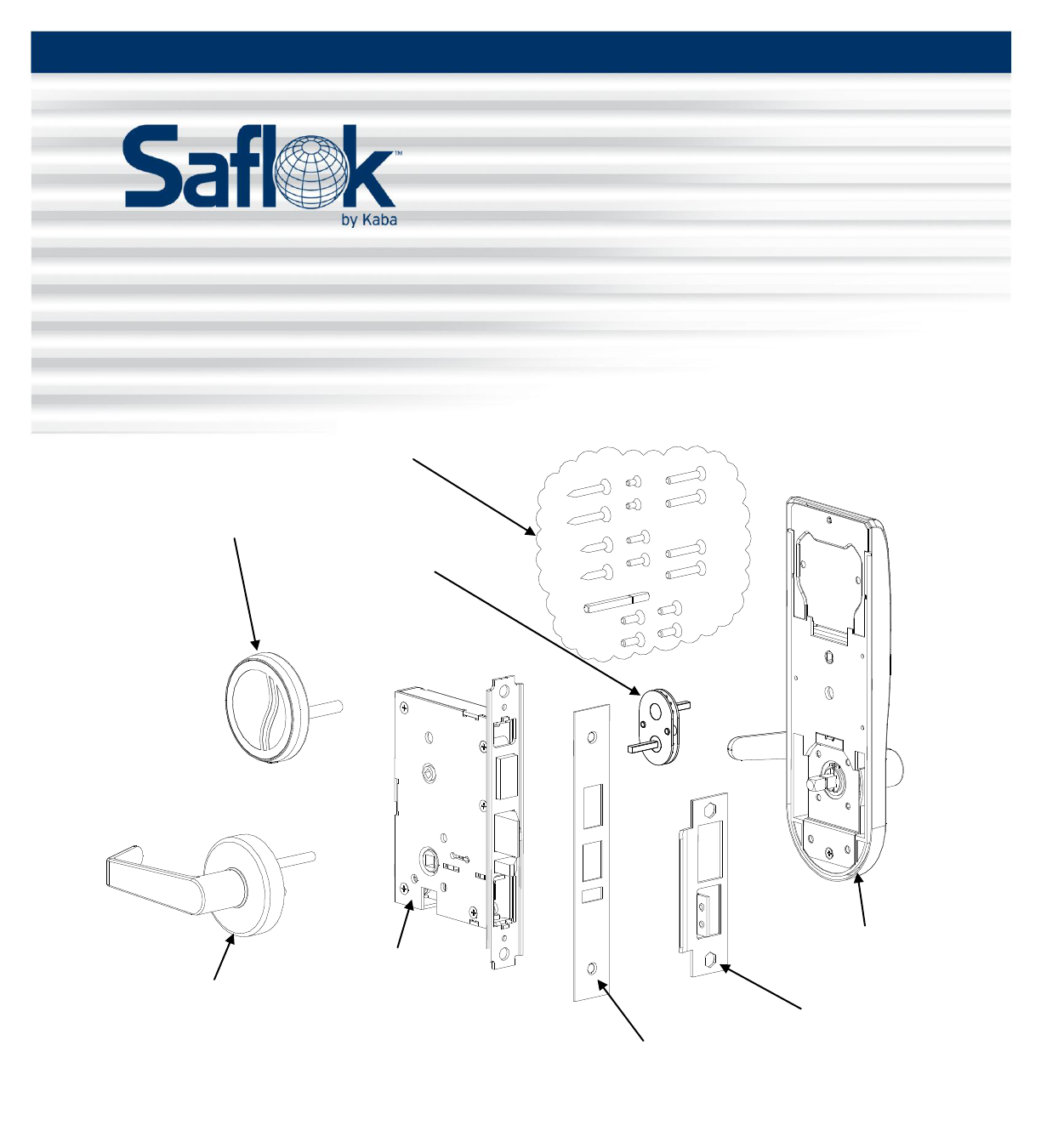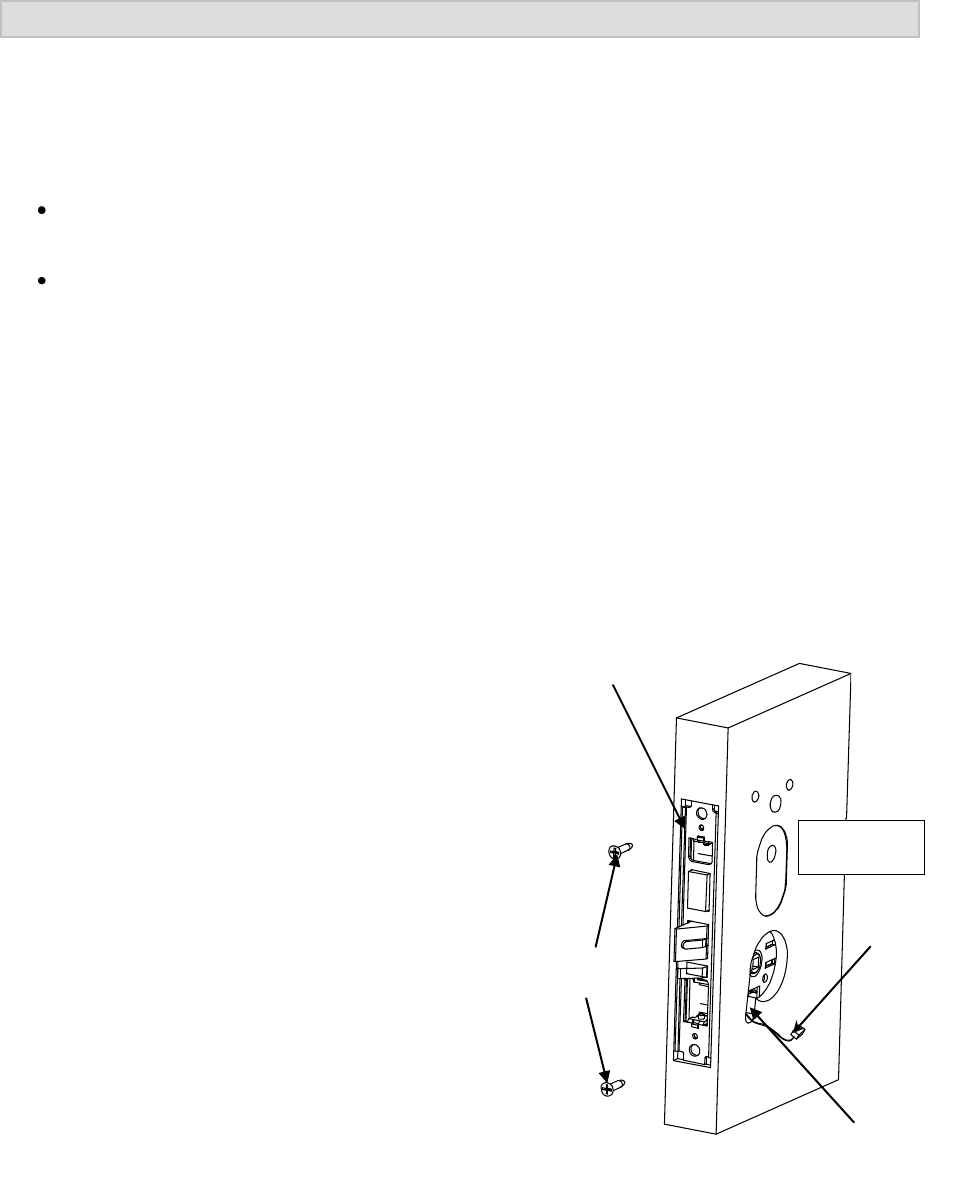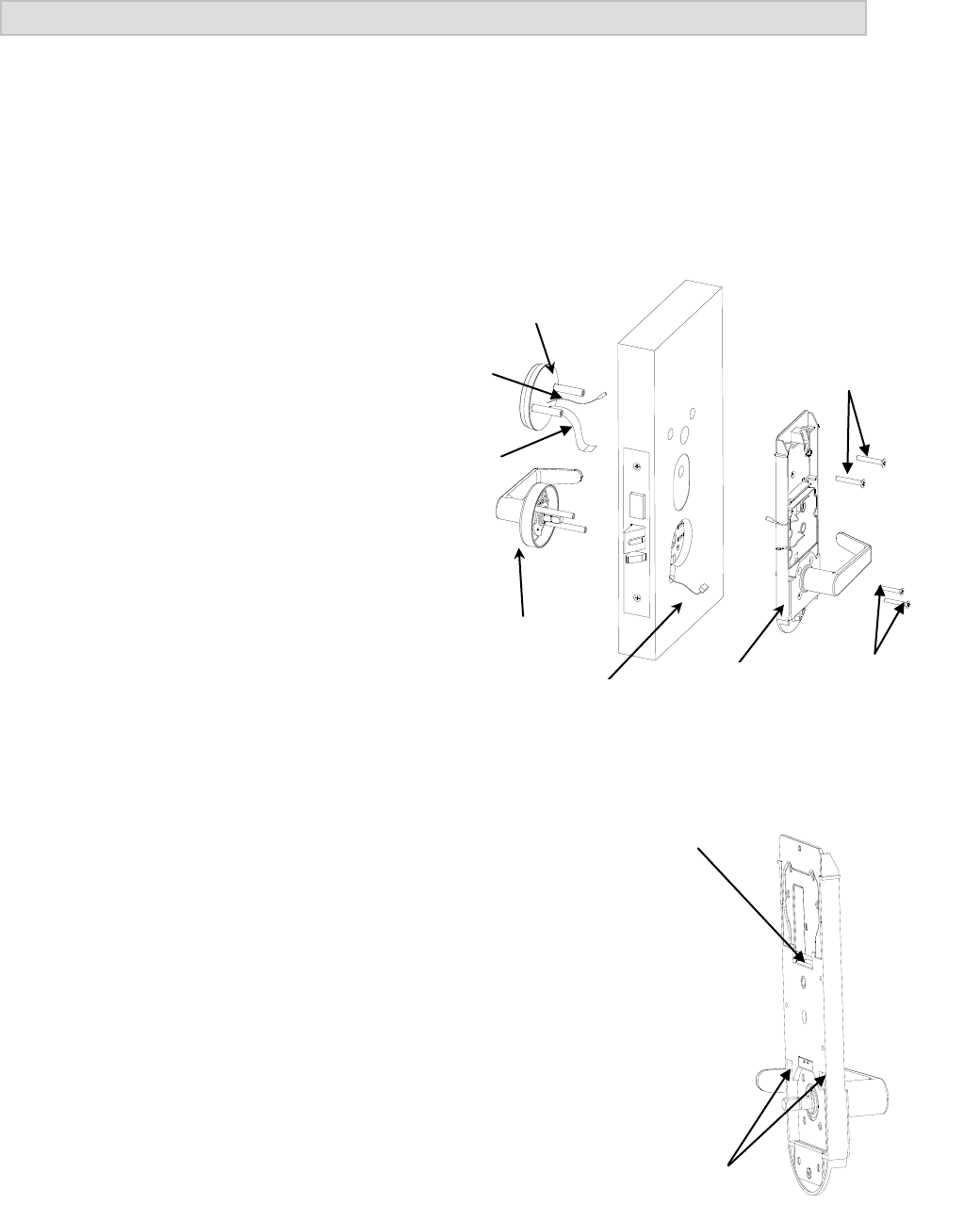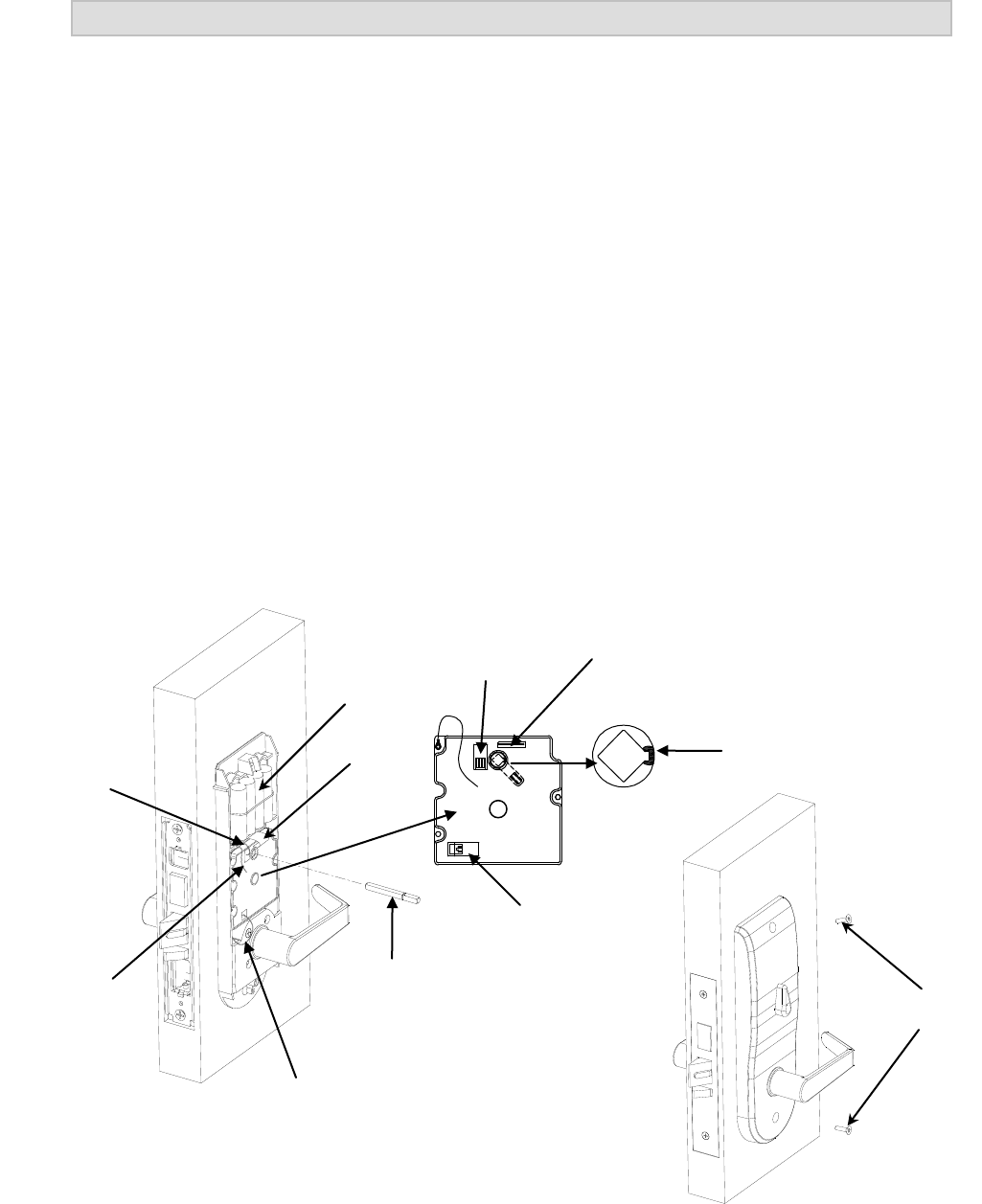dormakaba Canada QUANTUMRF2R RFID card reader used to access security devices User Manual QUANTUM MT
Computerized Security Systems, Inc. RFID card reader used to access security devices QUANTUM MT
user manual

Quantum™ RFID Pg. 1 of 6
© SAFLOK WL 7/07
Outside Lever Trim
(A20970-HAND-COLOR)
Mortise Lock
(A59810-HAND-G)
Mortise, Std.
OR
(A59850-HAND-G)
Mortise, ADB
OR
(A60000-HAND-G)
Mortise, MT, STD, DAJ
OR
(A59990-HAND-G)
Mortise, MT, ADB, DAJ)
Scalp Plate
(51190-COLOR)
Strike Plate
(30320-HAND-COLOR)
Inside Trim Assembly
(QP12XXX-6-XX)
Quantum™ RFID
Installation Instructions
All parts needed to install the Quantum™ RFID lock are included with each unit. Please check to make
sure all parts are accounted for before beginning installation. Do not substitute any of the parts. The use
of substitute parts will result in poor performance of the lock.
All information contained herein, including but not limited to product pricing and other intellectual property, is confidential and
intended for the sole use of the addressee(s) so named. Any misuse of this confidential information contained herein may result in
legal action by Computerized Security Systems dba SAFLOK and its parent company.
Screw Pack
(A29050-COLOR)
Proximity Reader Assembly
(A20910-COLOR)
Gear Box
For the standard
mortise only
(24012-1)

Quantum™ RFID Pg. 2 of 6
© SAFLOK WL 7/07
Mortise
Screws
Motor
Wire
Fig. 1
Preparing the door and door frame
1. Prepare the door using the Quantum RFID installation template or drill fixture. The door edge prep is
a standard, full-mortise prep for a 1-1/4” x 8” front plate (1” x 8” and 1” x 7-3/4” custom front plates are
optional). The door surface holes and mortise are customized for the SAFLOK trim.
Important: Some holes are only on the inside surface of the door.
For new construction installations, the door manufacturer may prepare the door using the
installation template.
For retrofit installations, remove the existing hardware and confirm that the existing door edge
prep is appropriate for the SAFLOK mortise lock.
Drill fixture: If you are using a SAFLOK drill fixture, position and clamp the fixture on the door. The
fixture has two positioning posts that rest inside the mortise, establishing the proper backset for the
trim. When the fixture is clamped, its surfaces should be parallel with the door surfaces and door
edges. Not all holes go through the door (refer to the template). Notch the material on the inside
surface for easier routing of the motor wire. After machining, remove any debris from the mortise and
cutouts.
2. Prepare the door frame using the template and install the strike plate using the screws provided
(12 x 1-1/2 screws for wood frames, 12-24 x 3/8 screws for metal frames).
3. The mortise plate has an adjustable bevel. Align the mortise front plate with the bevel of the door
edge and tighten the two bevel adjustment screws at the top and bottom of the mortise case. Position
the mortise case in the door edge with the motor wire routed through the notch (see Fig. 1).
Note: Use care to ensure that the wires do not get
pinched or pulled as the mortise is inserted into the
pocket.
4. Attach the mortise front plate to the door using the two
mortise screws (12 x 1-1/4 screws for wood doors,
12-24 x 3/8 screws for metal doors). Be sure that the
screws are fully tightened.
Important: DO NOT leave the screws loose. The screws
must be fully tightened before the trim is installed. If you
must leave the mortise loose to install the trim, the door
preparation is incorrect.
5. Install the scalp plate with the 8-32 x 1/4 screws
provided and test for proper mechanical latch
engagement into the strike plate.
Mortise Front Plate
Notch for routing
the motor wire
(inside only)
Inside Door
Surface

Quantum™ RFID Pg. 3 of 6
© SAFLOK WL 7/07
Installing the lock trim
The outside lever trim has two carriage bolts that fit into the diagonal holes in the mortise case. These
carriage bolts establish an accurate trim position with respect to the mortise case assembly, allowing the
levers and bolt mechanism to operate without binding. The holes machined in the door surfaces should
not influence the position of the trim or the proximity reader assembly.
Do not tap or bend the carriage bolts to manipulate the fit of either trim piece during installation. The door
prep holes should accommodate the outside lever trim and the proximity reader assembly. If the carriage
bolts or proximity reader enclosure fit too tightly in the door prep holes, then remove the mortise and
enlarge the holes to achieve a free fit.
1. Remove the battery pack and retaining
spring.
2. Position the outside proximity reader
assembly on the outside of the door (see
Fig. 2). Route the ribbon cable and power
cable through the 13/16” hole in the door.
Do not pull on the ribbon cable.
3. Route the ribbon cable and power cable
through the rectangular hole in the inside
trim. Do not pull on the ribbon cable. This
hole is located above printed circuit board
(PCB) assembly. Route the motor wire
through the wire channel in the inside trim
closest to the door edge. These holes are
located below the PCB (see Fig. 3).
4. Position the inside trim on the inside of the
door.
5. Secure inside trim to the proximity reader
assembly using two M5 x 31 mm screws.
Important: Do not fully tighten the screws at this point.
6. Align the outside lever trim with the diagonal holes located on
either side of the mortise hub and secure it by starting the two
8-32 x 1-1/4 screws (see Fig. 2).
7. Once the outside lever trim is fully secured, check the alignment of
the inside trim and be sure that the both levers rotate without
binding. Once the trim is properly aligned, fully tighten the four
screws that secure the trim to the door and check for proper rotation.
8. Place the battery pack in position above the PCB and secure it in
place using the retaining spring. Be sure that the battery wire is
routed through the lower left corner of the battery compartment.
9. Connect ribbon cable and motor cable to the PCB.
8-32 x 1-1/4
Screws
Outside Lever
Trim
Fig. 2
Inside Trim
Motor Wire
Proximity Reader
Assembly
Route the ribbon
connector through the
rectangular hole
Fig. 3
Motor Wire
Channels
M5 x 0.8g x 31 mm
Screws
Power Cable
Ribbon Cable

Quantum™ RFID Pg. 4 of 6
© SAFLOK WL 7/07
Installing the lock trim (continued)
10. Watching for the green LED on the proximity reader to flash four times, connect the battery wire to the
PCB. The green light indicates that the PCB has reset.
Important: The battery wire should be the last connection made to the PCB.
11. With the dead bolt retracted, insert the long end of the dead bolt spindle assembly through the PCB
switch cam hole and into the mortise dead bolt hub. The indicator marks on the switch cam should be
at the right (3:00 position) when the mortise dead bolt is retracted (see Fig. 4). The retaining ring
should rest on the switch cam when fully inserted (the proper positioning of the cam will allow the
door to be opened when the dead bolt is retracted and block entry when the dead bolt is thrown for
privacy, except when emergency keycards are used). Position dead bolt spindle assembly into cam
assembly.
Important: As illustrated in Fig. 4, be sure that the cam is in correct orientation.
12. Install the inside escutcheon with the thumb turn pointed upward.
13. Secure the inside trim cover to the inside trim using two color-matching M4 x 16mm Torx screws (see
Fig. 5).
14. Program the lock using the Quantum RFID LPI Probe. Test the functioning of the lock as discussed in
the following section and the programming manual before closing the door. When the construction
key is used, the red and green LEDs will blink together, indicating that the time and date are not set.
Battery
Ribbon
Green Ground
Wire
Battery
Wire
Dead Bolt
Spindle
Assembly
M4 X 16mm
Torx Screws
Fig. 4
Fig. 5
3:00
Position
ADB
Mortise
Motor Wire
Ribbon
Connection
Motor
Connection
Battery
Connection
(last)

Quantum™ RFID Pg. 5 of 6
© SAFLOK WL 7/07
Testing Lock Functionality
Pass a Construction key over the Quantum RFID LPI probe. Be sure that the green light flashes for five
seconds while the exterior lever remains operable. If the green light does not flash, refer to the table
below.
Lock Communication Electronic Function Description
Red and green LEDs flash Time and date not set, use the Quantum RFID LPI probe to reset
nine times simultaneously
Yellow LED flashes 12 times Dead bolt is thrown or switch cam is not properly aligned
Yellow LED flashes two times Keycard not allowed OR keycard cancelled by new keycard
Red and green LEDs flash Low battery (contact the SAFLOK service department)
alternately nine times
Yellow and red LEDs flash Bad keycard read or corrupted data (may require new
two times simultaneously keycard)
Red LED flashes two times Keycard not read (keycard inserted upside-down, wrong end,
wrong key?)
SAFLOK Door Unit Inspection Criteria
Appearance
Finish is free of blemishes or scratches that would distract from lock appearance
Lock body and under plate (if used) are mounted straight on the door
Door scalp is mounted straight and flush with the door edge
Jamb strike is mounted straight and is flush with the jamb face
Correction of minor blemishes on the door jamb are the responsibility of the property’s maintenance
department
Lock Function
Knob or lever rotates and moves freely
Lever is horizontal to floor when at rest position
Dead bolt extends fully and retracts without binding (door open)
Lock latch and dead bolt engage jamb strike plate freely
Anti-pick latch when depressed (door open)
Anti-pick latch is depressed when contact is made with the strike plate (door closed)

Quantum™ RFID Pg. 6 of 6
© SAFLOK WL 7/07
Electronics/Keycards
Keycard can be inserted and withdrawn freely
Yellow light flashes twice when incorrect keycard is used
Red light flashes twice if keycard is used incorrectly and cannot be read
(e.g., a credit card is used)
Green light flashes when the proper keycard is used
Green light is flashing when the lever is operated
Green light continues to flash for a five-second cycle
Yellow light flashes 12 times when the dead bolt is extended and a guest/hotel
keycard is used
All keycards function to the specifications of the master plan
Door function
Door closes and latches with little or no interference
Dead bolt extends fully through the strike plate without interference (door closed)
Spacing between door edge and inside door jamb does not exceed 3/16” (door closed)
Note: If bumpers or other seals are added after strike plate installation and causes alignment and latch
problems, it is the property’s responsibility to correct this condition. This note generally applies to new
construction or new door installation.
FCC and IC Warnings:
This device complies with part 15 of the FCC Rules. Operation is subject to the following two conditions:
(1) This device may not cause harmful interference, and (2) this device must accept any interference
received, including interference that may cause undesired operation.
Changes or modifications not expressly approved by the party responsible for compliance could void
the user's authority to operate the equipment.
This device complies with Industry Canada licence-exempt RSS standard(s). Operation is subject to the
following two conditions: (1) this device may not cause interference, and (2) this device must accept any
interference, including interference that may cause undesired operation of the device.
Cet appareil est conforme avec Industrie Canada RSS standard exempts de licence (s). Son
fonctionnement est soumi aux deux conditions suivantes: (1) cet appareil ne peut pas provoquer
d'interférences et (2) cet appareil doit accepter toute interférence, y compris les interférences pouvant
entraîner un mauvais fonctionnement de l' appareil
Questions? Call Customer Service at 800.999.6213 and select option 3.